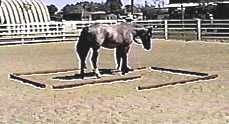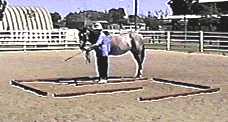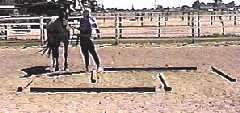Teaching Horses to Lead Lightly
|

|
|
Nobody likes to struggle with a horse on a lead line; to have the horse
forge ahead or crowd the handler or worse yet, step on the handler's feet.
While the handler is responsible for most of these errors, some simple
training can help transfer some of this "responsibility" over to the horse
by teaching him to be aware of his body and where he is in relation to you
and objects which he encounters.
We use a slight variation of Linda Tellington-Jones' "wand and labyrinth" drill and we have found it to be easy to set up, easy to teach and extremely reliable.
We want to develop a horse who is thinking, alert and aware of his surroundings and the handler who is leading him. He should know where he belongs in relation to the handler, yet at the same time be able to navigate through objects on the ground. The horse should be able to recognize cues to walk, stop, back, turn toward the handler and yield away from the handler. The horse should be able to transfer this knowledge to riding situations and respond lightly to the rider's aids.
We will need six 8-foot poles, a "wand", a 12 foot lead rope and a rope halter. The wand is simply a buggy whip or longe whip with the tassel taped down, either light colored or wrapped in white first aid tape to make it very visible. (If you don't have a rope halter, you can use a stud chain, passing it through the near halter ring, then wrapping it around the nose band and clipping to the far halter ring.)
The poles are placed to create evenly spaced overlapping "U"s. The "U"s should overlap two to three feet. The corners should be square and all poles set at "true" 90 degree angles to each other. Hue Simpson is presenting Dahlia to the labyrinth.
|
| PREPARING THE HORSE |
Before we present the horse with the labyrinth, we want to make sure he is comfortable and responding to the aids and equipment which we are using. We will lead the horse out in the open, making wide turns and working on position.
To do this, we start out on the left side of the horse, standing about even with the shoulder. The rope is clipped onto the left hand side of a rope halter at the intersection of the noseband and the cheek. If a web halter is being used, a stud chain is fed through the near cheek ring, woven around the noseband, and clipped to the far cheek ring. We hold the rope with our little finger closest to the halter. We have enough slack in the halter rope so that we could touch the tip of the horse's ear without tugging the rope (probably a little lower with mules and burros).
In our left hand we will hold the "wand". We will position the wand so that it is held horizontally, passing the bridge of the horse's nose. The wand will act as a moving barrier so that the horse will learn not to press forward excessively and "drag" the handler.
To start out, we "open up" the door created by the wand by gesturing it forward and asking the horse to step forward. At this point we must move forward with the horse. If the horse lags behind, we will apply a little more forward pressure. If he surges forward, we will shake the wand up and down to emphasize its position, lightly tapping his nose if needed. To turn toward us, we will direct with the wand and lightly take up the lead rope if necessary. To turn away, we will direct the wand accordingly and place our right hand up by the horse's eye to get him to yield.
This is not a timed event. The exercise should be conducted quietly and thoughtfully. When the horse is moving reasonably well, not crashing through the wand or drifting into or away from the handler, he is ready to approach the labyrinth.
| WALKING THROUGH THE LABYRINTH |
Before we walk through the labyrinth, we will walk around it in both directions, letting the horse explore the poles and sniff them a little. He should be aware of their presence, but not be distracted by them.
Next we will line the horse up at one of the labyrinth openings. Taking a few steps at a time, we will guide the horse through the labyrinth, keeping slightly to the "outside" of the center of the lane. At the first bend, we will stop the horse, let him look at the layout, then by "leading" with the wand as well as gently suggest with the lead rope, we will draw the horse toward us and around the arc of the first "U".
Hue leading dahlia, "opening up" with the wand
to reinforce the aid to move forward

At the end of the second lane, the horse again is allowed to look around and, encouraged by the wand, is asked to yield to the right and complete the turn within the boundaries of the ground poles. At first, the horse may be a little clumsy and may need the entire width of the lane so the handler may have to step outside the poles from time to time to keep the horse in position. The horse may foul up and bump the poles around. Don't worry, reset the labyrinth and try again. Remember that the horse is developing a new skill and may need some practice before getting smooth at it. As the horse gets more proficient, we can decrease the use of the aids.
Coming to the end of the second lane,
Hue preparing Dahlia to yield to the right

Once the horse is working well on the "on" side, then work the labyrinth from the opposite side of the horse. We also teach the horses to back through the labyrinth as well as to walk, then trot in a straight line over the four overlapping poles.
With Dahlia, we tried her again on the labyrinth the next day. She was good enough that she could walk it flawlessly with the lead rope laying over her back, just following the wand. A couple of days later she walked it with nothing more than my body presence establishing the "tempo".
| PAYOFF TIME! |
We now have a horse who leads quietly on or off lead and who is aware of where we are and what we are doing. We also have a horse who handles light in the saddle. When saddled, Dahlia walked the labyrinth cleanly with very little effort from her very first attempt. In the turns, we applied the slightest suggestion with our hands, moved her forehand around the "U" with our outside leg (using "indian wrestling" pressure along the girth), then moved her hind end around the "U" with our inside leg (applying calf pressure near the rear cinch area). Having some idea what we were trying to accomplish already, she picked up very fast on our leg aids. Shortly after, she would similarly yield lightly to leg pressure in the open area of the arena, moving her forehand or hindquarters off of leg pressure as "asked."
Press "Back" to return to the page that brought you here
Go to Case Study Section
Return to Training Section
Return to Wild Horse Mentors
Return to KBR World of Wild Horses and Burros
Go To  KBR Horse Net
KBR Horse Net
KBR Horse Training Information, © 1997
Lamm's Kickin' Back Ranch and Willis & Sharon Lamm. All rights reserved. Duplication of any of
this material for commercial use is prohibited without express written permission.
This prohibition is not intended to extend to personal non-commercial use, including sharing
with others for safety and learning purposes, provided this copyright notice is
attached.
Email us to submit comments or
request reproduction permission.

